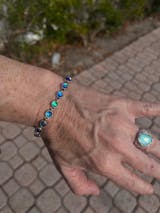Throughout history, the concept of fertility has been significant in various cultures and societies. Fertility represents more than just the ability to birth children; it also represents development, abundance, prosperity, and the nurturing of all forms of life. The "Goddess of Fertility Charm," which is often embodied in various forms such as figurines, amulets, and talismans, has been revered for generations for its supposed power to enhance fertility and bring blessings of growth and prosperity. In this blog post, we will look at the symbolism, historical context, and present significance of the Goddess of Fertility Charm.
The Goddess of Fertility Charm is steeped in the symbolism of femininity, creativity, and the nurturing side of existence. Typically, these charms depict the feminine form with exaggerated features like as big breasts, hips, and a rounded tummy, all of which are associated with fertility, motherhood, and the ability to give birth. These symbols represent not just biological reproduction, but also the fertility of the ground, creativity, and the wealth of communities. For many, the charm represents divine feminine energy—the embodiment of creation, nurturing, and life's cyclical nature. It serves as a reminder of the sacred power of the feminine principle, which is present in all living beings regardless of gender. These charms are frequently used as a spiritual tool to summon blessings, increase fertility, and connect with the nurturing energy of the universe.
The concept of a fertility goddess is prevalent to many ancient societies' mythology. Each culture has its own fertility goddess, often with different names and forms but with the same fundamental purpose: to provide fertility and plenty. The Venus of Willendorf, one of the most renowned fertility charms, is a tiny sculpture from the Paleolithic period with exaggerated female features that is thought to have been used in fertility rites and as a talisman to promote good pregnancies. Similarly, Isis, an important goddess in Egyptian mythology, was connected with fertility, childbirth, and sorcery. In ancient Egypt, amulets and charms featuring her picture were popular for protecting women and children, as well as promoting fertility and healthy childbirth.
In Greek mythology, Aphrodite is recognized as the goddess of love, beauty, and fertility, and she is worshipped with offerings and charms designed to increase fertility, both in terms of childbearing and land fertility. In Norse mythology, Freya is another goddess linked with love, fertility, and war; her charms were thought to bring out not just love and desire, but also crop and animal fertility. Tlazolteotl, the Aztec goddess of fertility, childbirth, and sexuality, was summoned by women in labor to purify their bodies and assure reproduction. Each of these deities and their accompanying charms had an important part in their respective cultures, representing not just spiritual symbolism but also societal virtues such as life, fertility, and feminine authority.
Fertility charms were more than just jewelry; they were commonly employed in rites and ceremonies to attract divine benefits. These charms were frequently worn by women attempting to conceive, hung in homes, or placed on altars as gifts. Rituals involving fertility charms may involve prayers, chants, and the usage of sacred herbs and oils, all with the goal of improving the individual's or community's fertility and health. Fertility charms were also passed down through generations in many ancient societies, becoming heirlooms that represented a family or community's collective wishes, blessings, and prayers. These charms were thought to contain powerful powers, filled with the love and intentions of those who created and utilized them.
While the ancient civilizations who worshipped these fertility goddesses may no longer exist, the Goddess of Fertility Charm is still relevant today. Today, these charms are sought after not only by people attempting to conceive, but also by anyone seeking to tap into the energies of development, creativity, and abundance. In contemporary spiritual traditions, the Goddess of Fertility Charm is frequently seen as a symbol of female empowerment and the reclaiming of the divine feminine. It acts as a reminder of our innate ability to create, nurture, and transform. Many people today use fertility charms into their holistic health and wellness routines. Whether used in yoga, meditation, or energy therapy, these charms help to balance and harmonize the sacral chakra, which is related with creativity, sexuality, and fertility.
Fertility charms continue to be popular among individuals attempting to conceive. They are frequently given to loved ones as a means of providing emotional support and positive energy. Some people wear these charms as necklaces or bracelets, believing that they bring comfort and optimism during their fertility journey. Fertility charms are valued not just for their spiritual and metaphorical meaning, but also for their historical and artistic significance. Many collectors and enthusiasts seek these charms as examples of historical craftsmanship and cultural heritage. In the context of manifestation and personal development, the Goddess of Fertility Charm serves as a focal point for setting intentions for abundance, creativity, and fresh beginnings. Whether you're starting a new project, launching a business, or going through a personal shift, these charms serve as a reminder to stay open to life's opportunities.
The Goddess of Fertility Charm is more than just an ancient symbol; it represents life, growth, and the caring power of the feminine. Whether used as a spiritual aid, a work of art, or a symbol of empowerment, these charms continue to inspire and carry meaning in modern times. Understanding their rich history and significance allows us to appreciate how these ancient talismans continue to guide and empower us on our travels towards fertility, creativity, and plenty.
For more inspiring insights and jewelry designs, please visit Leight Works Blog.


